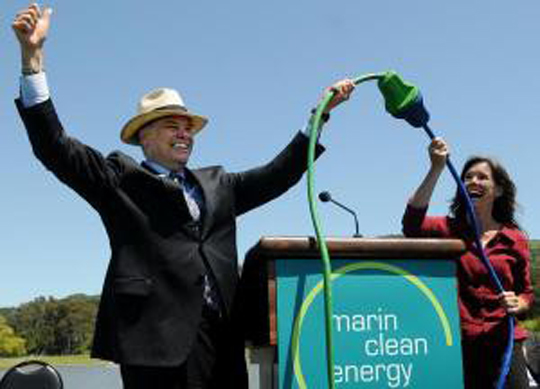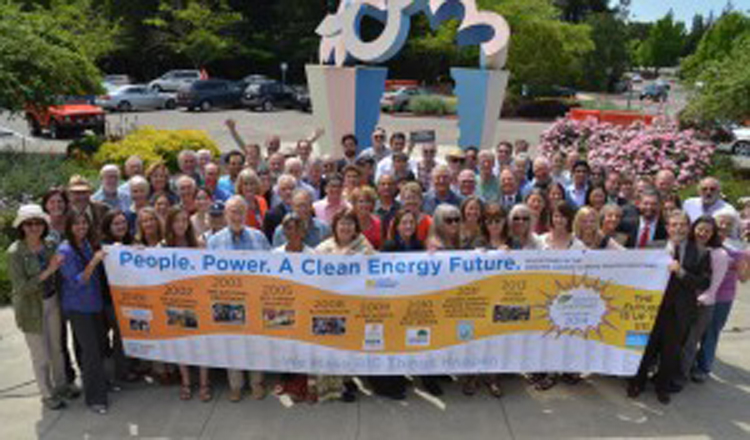Community Choice Aggregation Offers Local Governments Affordable, Locally Controlled Clean Power
Community Choice Aggregation Offers
Local Governments Affordable,
Locally Controlled Clean Power
We are at a crossroads…the challenge is to build for the future, not steal from it, to live within our means and to keep California ever golden and creative.
– Governor Jerry Brown
California is pushing forward more aggressive targets for climate mitigation and folding adaptation efforts into “business as usual” for state government. The Governor’s Executive Order B-30-15, issued last month directs state agencies to address climate-change impacts and adaptation strategies and sets a California greenhouse gas reduction target of 40% of 1990 levels by 2030 – establishing a benchmark between the state’s 2020 and 2050 goals.
One of the practical strategies that local governments are pursuing to increase resiliency and meet the energy-generation side of the climate equation is Community Choice Aggregation (CCA).
Earlier in May, representatives from California’s three current CCAs (Marin County, Sonoma County and the City of Lancaster) and interested local governments from across the state came together for a workshop on “Understanding Community Choice Energy: A Forum for California Local Governments” put on by the Local Government Sustainable Energy Coalition and LEAN Energy US with support from the Local Government Commission.
The message from experts across the state and the nation was clear – there is growing demand for cleaner, cheaper energy with more local control and the time to act is now.
“Now is the best time for CCAs to come on board because the price of power is at record lows,” said Barbara Boswell, Lancaster Choice Energy’s director.
“The faster you can form the better. Market conditions are more appealing than ever to do a CCA that has better, cleaner power than utilities,” Lindsay Lowe, Vice President of Constellation Energy Commodities Group concurred.
A Review of Community Choice Aggregation in California
Passed in 2002, the Community Choice Aggregation law (AB 117) allows cities, counties or joint power authorities to provide electricity and/or conservation measures to their homes and businesses, either by generating the energy themselves or purchasing it through the market. With the goal of reducing the cost of providing renewable power, a number of communities are now pursuing CCA’s.
The CCA legislation was developed in response to utility deregulation, when energy costs skyrocketed and consumers were left frustrated and angry about bills that were 50% higher than the national average.
The measure was supported by LGC members from San Francisco, Oakland, Berkeley, Marin County and a group of Los Angeles municipalities who were looking to take positive action to address the untenable situation.
Under CCA legislation, local governments are allowed to provide electricity to their customers, however existing investor-owned utilities (PG&E, Southern California Edison, SDG&E) still own and maintain the transmission and delivery systems. Consumers have the choice to opt out of the CCA, and stay with the investor-owned utility as their electricity provider.
At the time of its adoption, California State Energy Commission leaders viewed the CCA mechanism as an important opportunity to increase the use of renewable energy in California. However, to be successful, CCA cities needed to be able to offer the consumer renewable energy at rates at least comparable to what they were paying the investor-owned utility for a smaller percentage of renewable sources.
A CEC commissioner encouraged the LGC to apply for funding to research whether local governments could, indeed, provide that renewable energy to CCA customers at an equal or lower cost.
Based on research data from 2003-08, the study was published in 2009. It turned out that the answer was “yes” – in general, local governments, as nonprofit entities, do have the ability to provide electricity to their residents at a reduced cost: they don’t pay taxes, have access to cheaper financing, and don’t pay dividends to shareholders. If a CCA generates electricity locally, there is less power lost from transmission over long distances.
The Community Choice Aggregation Pilot Project Study is available through the Local Government Commission.
Local governments now have the advantage of drawing from the successes of Marin and Sonoma counties to show feasibility. As Geof Syphers with Sonoma Clean Power said, “the best feasibility study now is a bid.”
A jurisdiction can put out a bid or request for proposals to determine if they can purchase cleaner power for cheaper than the price of power they get from their utility.
Marin County Powers Up

Marin County was the first to launch a CCA program, Marin Clean Energy , in California in May 2010, spearheaded by the late community champion Supervisor Charles McGlashan. The project is administered by a joint powers authority encompassing the County and the communities of Belvedere, Corte Madera, Fairfax, Larkspur, Mill Valley, Novato, Ross, San Anselmo, San Rafael, Sausalito and Tiburon. Today, 80% of Marin County customers enjoy lower rates and at least half of their power is supplied by renewable sources. Marin Clean Energy customers saved more than $5.9 million in energy bills during 2014 and expect even greater savings this year. Marin customers can also voluntarily elect to pay slightly higher rates for “Deep Green” 100% renewable electricity or “Local Sol” electricity that is 100% from local renewable projects.
Marin Clean Energy now serves neighboring communities outside of the County as well including unincorporated Napa County and the cities of Benicia, El Cerrito, Richmond and San Pablo.
Marin‘s program has been honored with a well-deserved Green Power Leadership Award from the U.S. EPA.
The Number of Participating Local Governments Grows
Marin County has proven that CCAs work, and others are following their lead.

Sonoma Clean Power CCA is currently serving the cities of Cloverdale, Cotati, Petaluma, Rohnert Park, Santa Rosa, Sebastopol, Sonoma, the Town of Windsor and unincorporated areas of the county offering power that is currently 34% lower in Greenhouse Gas emissions with rates 5 to 8% lower than PG&E.
The City of Lancaster started early enrollment in their new CCA this month and will expand throughout the city in October.
Monterey Bay Community Power has enrolled Santa Cruz, San Benito and Monterey counties and all of their 18 cities. A feasibility study has been completed, and the group is looking to start up this summer.
To become a CCA, a jurisdiction must first receive a letter of permission from the California Public Utilities Commission. At least 40 local governments have gone through that process. Jurisdictions site a number of reasons for starting a CCA that include local control of electricity pricing and energy sources, local economic benefits and a transition to clean power (solar, wind, geothermal).
Some of the earliest applicants were San Francisco and the San Joaquin Valley Power Authority, which serves Kings County and the cities of Clovis, Corcoran, Dinuba, Hanford, Kerman, Kingsburg, Lemoore, Parlier, Reedley, Sanger and Selma. Both of these regional efforts continue to move forward.
Since 1977, Californians Have Saved $74 Billion in Reduced Electricity Bills
During his first stint as Governor, Jerry Brown set California in motion to become the second most energy-efficient state in the country. He spearheaded the addition of energy-efficiency regulations to the State‘s building code, implemented in 1978.
By 2012, California was using less energy per capita than any other state except for Vermont. This was accomplished in large part by implementing energy-efficient building standards that have continued to be updated over the years, saving Californians at least $74 billion in reduced electricity bills since 1977.
But also seminal was the establishment of the SolarCal Local Government Commission, the forerunner of the current LGC, in 1979. At that time, only two local governments in the nation had local energy conservation and/or renewable energy measures on the books.
San Diego County had adopted a solar water-heating ordinance, and the City of Davis had implemented the country‘s first energy conservation building standards, preceding the State‘s standards by over a year. Today, the vast majority of California‘s local governments have a renewable energy and/or energy conservation program.
From our inception as a state commission under Jerry Brown in the late 1970’s and our formation as a nonprofit in 1981, the LGC has supported the three pillars of the Governor’s 2030 goals outlined in this year’s inaugural address – reaching 50% renewable energy, cutting in half our vehicle fuel use, and doubling the energy efficiency of existing buildings.
We’ve also helped to blaze the trail for the adaptation and mitigation measures in the Governor’s recent Executive Order B-30-15.
These goals are clearly within reach. The State is already on track to meet the current goal of 33% energy from renewable sources by 2020. California is now the national leader in installed solar capacity and third in energy from wind and geothermal.
“We are at a crossroads,” Brown said. “The challenge is to build for the future, not steal from it, to live within our means and to keep California ever golden and creative.”
California local governments are continuing to play a leading role in this effort.
For more information on CCA’s:
Community Choice Aggregation Pilot Project funded by California Energy Commission Public Interest Energy Research Program prepared by the Local Government Commission and Navigant Consulting, Inc. (2009)
Community Choice Aggregation Fact Sheet funded by California Energy Commission and Department of Energy prepared by the Local Government Commission
Local Government Commission Newsletters
Livable Places Update
CURRENTS Newsletter
CivicSpark™ Newsletter
LGC Newsletters
Keep up to date with LGC’s newsletters!
Livable Places Update – April
April’s article: Microtransit: Right-Sizing Transportation to Improve Community Mobility
Currents: Spring 2019
Currents provides readers with current information on energy issues affecting local governments in California.
CivicSpark Newsletter – March
This monthly CivicSpark newsletter features updates on CivicSpark projects and highlights.



